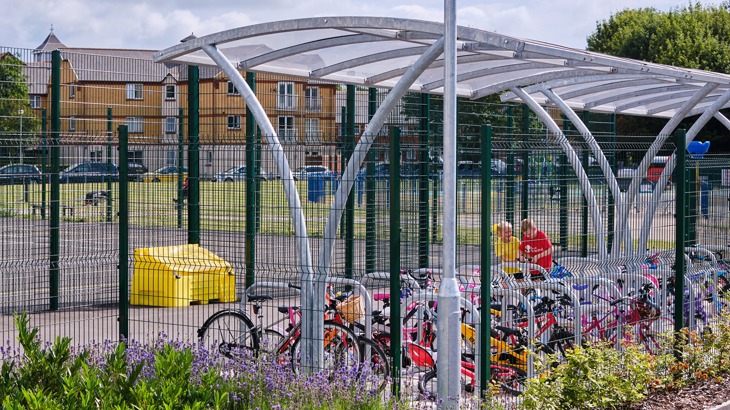During the lockdown, we've seen cycling, walking and scooting increase tenfold. But there have been reports of schools closing bike and scooter sheds and asking pupils not to cycle to school. Our Head of Behaviour Change, Chris Bennett looks at why it's crucial that schools support an active school run, now more than ever.

During the lockdown, we've seen cycling boom, with sales of bikes soaring and thousands of families getting out on their bikes for the first time.
This presents a massive opportunity to transform how we get to and from school, with stressful car trips replaced by safe and active means of travel.
Pre-Covid on weekday mornings, one in five cars on our roads were on the school run, with many schools facing dangerous levels of pollution.
There have been reports of schools asking pupils not to scoot or cycle, or closing bike and scooter sheds.
Banning cycling and scooting is counter-productive
We appreciate that schools have got to make adjustments to enable social distancing, however not allowing cycling and scooting will be counter-productive and create further problems, affecting children’s health and wellbeing.
Social distancing requirements have reduced the capacity of public transport.
If parents decide to drive instead, it will create congestion and chaos outside the school gate.
And there is a greater risk of road traffic accidents as well as social contact. Traffic levels in some places are now already higher than pre-Covid levels.
We need to encourage an active school run
In order to address this, the government has called on all schools to strongly promote walking and cycling. If schools ban scooting and cycling it will undermine this message.
Walking, scooting and cycling is a much more efficient way for children and young people to get to school than driving.
We should not forget that physical inactivity, obesity and exposure to air pollution are at least as big a threat to children and young people than catching Covid-19.

Not allowing cycling and scooting is counter-productive and will affect children’s health and wellbeing.
We’re calling on schools and local authorities to do what they can to make it safe to bring cycles and scooters to school.
Here's what we think needs to happen.
Increase cycle and scooter storage
Create additional storage so that cycles and scooters can be spread out.
Storage doesn’t need to be covered, it just needs to be secure. It won’t cause cycles or scooters any damage if they get a bit wet if it rains. This could be done alongside a fence or wall.
Restrict access when not in use
Clear procedures should be in place to ensure that other children and staff do not come into contact with cycles and scooters.
For example, schools can close bike sheds during school hours after drop-off and before pick-up.
Dedicate an entrance for cycling and scooting
If possible, dedicate one entrance for cycling and scooting.
This will enable pupils on bikes to get in and out of school quickly and in accordance with social distancing. Staggered starting times can also help with this.
Provide space to store bags and helmets
Provide hooks or tables for pupils to store bags and helmets either near their bikes and scooters or in a separate area.
Each social bubble could have its own storage area. This will avoid the risk of contact between social bubbles.
Make it easy for pupils to clean their hands
Provide hand sanitiser in the cycle and scooter storage areas.
This will make it easy for pupils to clean their hands as soon as they get into school, and before they leave for home.
Take part in Bike to School Week
Bike to School Week takes place from the 28 September to the 2 October 2020.
It's a great way for schools to promote and encourage pupils and families to cycle, walk or scoot to school.
There's a range of resources available including:
- school posters
- daily activities to be completed in class
- and a video guide with simple steps to check your bike is safe to ride.

We’re calling on schools and local authorities to do what they can to make it safe to bring cycles and scooters to school.
We need to avoid a spike in congestion and air pollution
It’s vital now more than ever to make walking, cycling and scooting easier and more appealing options for families than driving, to prevent a spike in congestion and air pollution in the streets around school gates.
To protect children’s health, wellbeing and futures, we need to work together to transform the school run and enable every pupil to get to school via healthy modes of transport.
How we can help
We've got lots of useful information on how to make sure the school run is active and safe after lockdown:
And if you're a school that needs further information on how to make cycling and scooting to school easier, please email our education team on education@sustrans.org.uk.
Find out more about this year's Bike to school week.





